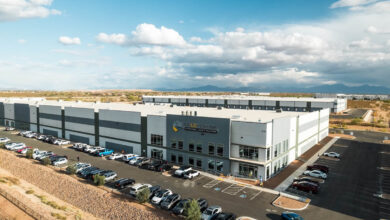
Pima Community College Ceramics Artist Marks Hiroshima Bombing
Pima Community College Ceramics Department Head Hirotsune Tashima’s most meaningful and personal work to date is a tribute to his grandfather, a Hiroshima firefighter during World War II who, in the weeks after the 1945 U.S. nuclear bombing of the city, helped survivors, despite exposing himself to the radiation that would lead to his early death.
Tashima’s “Little Boy (Hiroshima atomic bomb) Yellow Banana Kong – Give Peace a Chance,” is part of his solo exhibition, which was set to open this past July at Osaka’s Yoshiaki Inoue Gallery. The piece, part of a series he’s been building for years, is a 5-foot, 3-inch tall King Kong emerging from a larger-than-life banana while holding a rose in one hand and a broken Boeing B-29 bomber in the other. Kong wears a traditional Japanese samurai kimono and hakama, with a samurai sword resting on his hip. The “Give Peace a Chance” part of the name is because Tashima learned English from The Beatles’ songs. The gallery, where he has shown since 2009, postponed the show until 2021 due to the COVID-19 pandemic.
Aug. 6, 2020, is the 75th anniversary of the Hiroshima bombing. Tashima, who was born in Hiroshima, says “Little Boy” is significant to him and his cultural history.
“That day, people going to work, to school and doing their job were instantly burned – 80,000 people died that day,” he says. “By the end of the year, more than 140,000 people died. That is like a quarter of the people in Tucson dying.”
Tashima recalls that on Aug. 5, 1945, his firefighter grandfather had travelled by train and bicycle outside the city to visit his grandmother, who was critically ill. He had intended to return to Hiroshima later that day, but his grandmother hid his bicycle until it was too late for him to catch the day’s last returning train.
“Next morning, when he was trying to go to work by train at 8:15 a.m. . . . he saw the flash of light and heard the indescribably huge sound after; then, he saw the mushroom cloud,” Tashima says.
Tashima’s grandfather got a ride to Hiroshima in a military car. The drive normally took 30 minutes, but instead took six hours because the car had to maneuver around dead bodies filling the road. When he arrived at the fire department, not far from the exhibition hall at the center of the blast (now the Atomic Bomb Dome, part of Peace Memorial Park), his grandfather found all that was left of his colleagues were skeletons.
“He felt so guilty – that he was supposed to die with them, but he survived,” Tashima recalls the story. “He was helping in the area for two weeks, but he was hit by black rain, and the secondary radiation was so severe, he started to lose his hair and have bleeding gums. So he was ordered to go back to the countryside where his grandmother was escaping.”
The U.S. dropped a nuclear bomb on Nagasaki, Japan, on Aug. 9, 1945. Tashima’s grandfather and others affected by the bombings or exposed to their radiation are known as “hibakusha.”
“He was living till I was in high school in his mid-50s,” Tashima says. “He died young because of the radiation from the atomic bomb.”
Tashima’s “Little Boy” sculpture also was chosen for this year’s International Ceramics Festival in Mino, Japan, also postponed until 2021. Another piece from the series received an honorable mention in the Korean International Ceramic Biennale 2019. And, in summer 2019, he received a bronze award in the China Changchun International Ceramic Art Invitational for another piece in the series. Yet another series piece was selected for Tucson Museum of Art’s Arizona Biennial 2018.

Tashima has taught at Pima since 1999. He received his under-graduate degree from Osaka University of Art and his Master of Fine Arts from Alfred University in New York.
He has exhibited his work, held workshops and lectures all over the world from France to New Zealand, Denmark, Hungary, China, Korea and Japan.# # #
Founded in 1969, Pima Community College is one of the largest multi-campus community college districts in the U.S. Pima offers degrees and certificates in more than 140 transfer and occupational programs on five campuses and more than 100 teaching sites throughout Pima County. To learn more, visit www.pima.edu or call (520) 206-4500.





